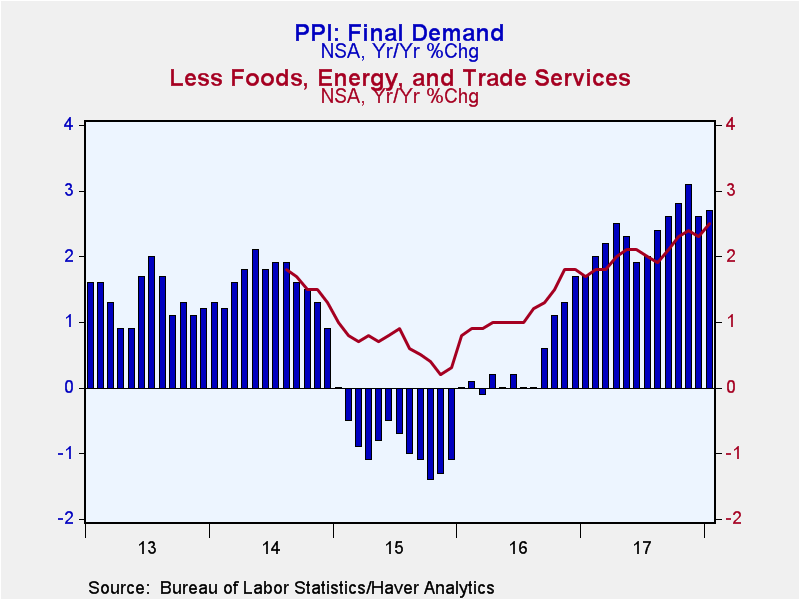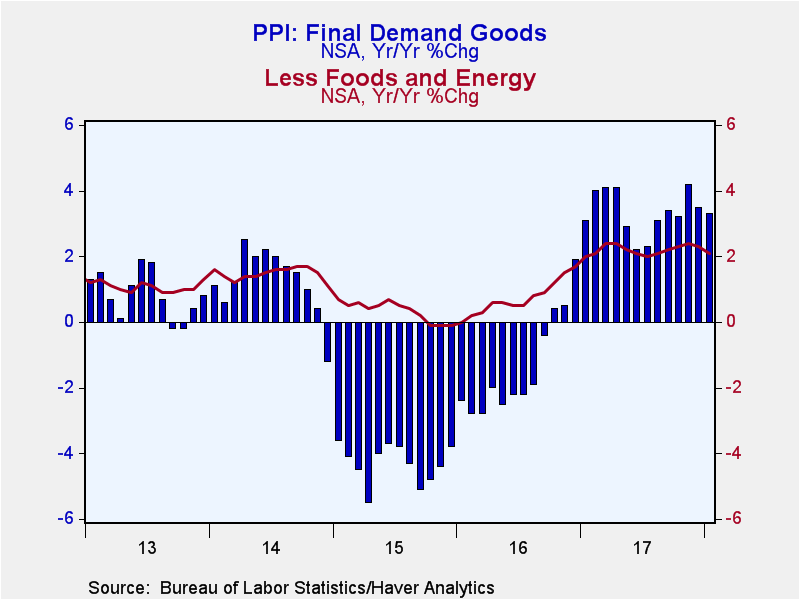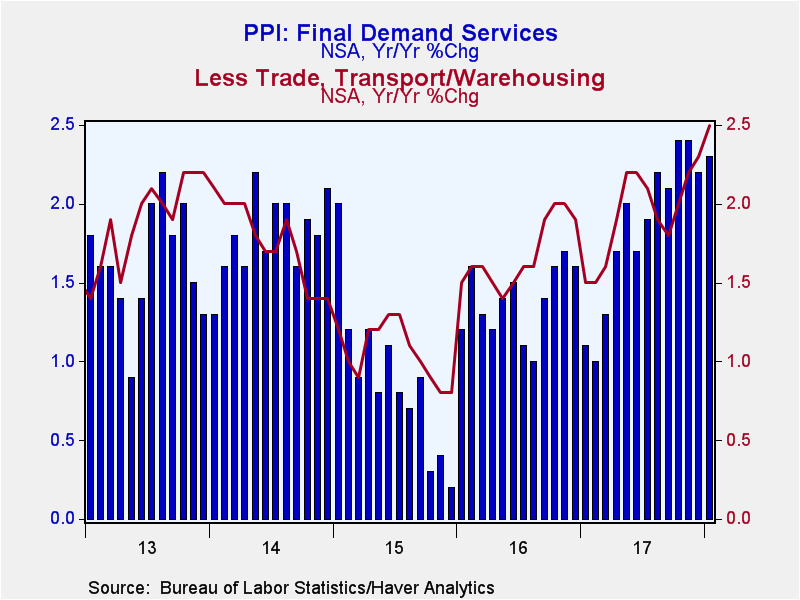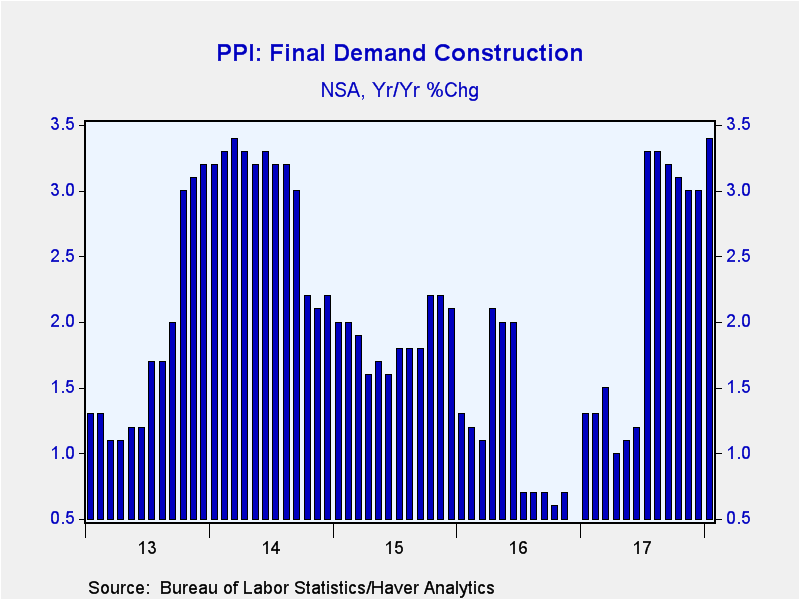 Global| Feb 15 2018
Global| Feb 15 2018U.S. Producer Prices Trend Upward
Summary
The headline Final Demand Producer Price Index using new methodology increased 0.4% in January following an unchanged reading in December. The year-on-year (y/y) gain edged up to 2.7%. A 0.3% January rise had been expected in the [...]
The headline Final Demand Producer Price Index using new methodology increased 0.4% in January following an unchanged reading in December. The year-on-year (y/y) gain edged up to 2.7%. A 0.3% January rise had been expected in the Action Economics Forecast Survey. The PPI excluding food & energy also increased 0.4% in January, well above the 0.2% expectation. Year-on-year growth decelerated slightly to 2.2% from 2.3% in December. An updated measure of core producer price inflation -- the overall index excluding food, energy and trade services -- showed the same 0.4% gain last month. This took the y/y growth to 2.5%, the strongest reading since the series began in August 2013.
Using the old methodology for the Producer Price Index, prices surged 0.7% (+3.0% y/y) in January following an unchanged reading. Excluding food & energy, the index edged up 0.1% (1.9% y/y).
Final demand goods prices jumped 0.7% (3.3% y/y) following a 0.1% rise. The goods price index excluding food & energy increased 0.2% (2.1% y/y).
Food prices declined 0.2% (+1.8% y/y) in January. Energy prices jumped 3.4% (9.2% y/y), as the price of West Texas Intermediate Crude Oil was up 9.9% in January (21.1% y/y). Thus gasoline prices surged 7.7% (12.9% y/y) and home heating oil prices increased 5.5% (19.6% y/y). Meanwhile natural gas prices fell 2.7% (0.9% y/y) and electric power costs rose 1.3% (3.9% y/y).
Nondurable consumer goods prices less food & energy edged up 0.1% (3.5% y/y) the second consecutive 0.1% gain. Durable consumer goods prices increased 0.2% (1.5% y/y) after an unchanged reading in December. Passenger car prices were unchanged (-0.6% y/y) and light truck prices declined 0.1% (1.5% y/y) following a 1.1% surge. Capital equipment prices increased 0.1% (1.0% y/y) after a flat reading in December. Manufacturing capital equipment rose 0.2% (1.6% y/y) while nonmanufacturing capital equipment showed another unchanged reading (0.8% y/y).
Final demand for services prices increased 0.3% (+2.3% y/y) in January. Prices less trade, transportation & warehousing gained 0.4%, bringing the y/y growth to 2.5%, the strongest reading since the series began in November 2009. Trade services prices rose 0.3% (+1.7% y/y) after two consecutive monthly declines. Private passenger transportation prices declined 1.6% (-3.6% y/y) after a 4.5% drop in December.
Final demand construction prices jumped 0.8% (+3.4% y/y) driven by 0.7% increase in private capital investment constructions (+3.4% y/y) and a 1.0% gain in government (3.6% y/y).
Prices for intermediate demand goods strengthened 0.7% (4.6% y/y). This is the sixth consecutive month of gains of 0.5% or greater.
The PPI data are contained in Haver's USECON database with further detail in PPI and PPIR. The expectations figures are available in the AS1REPNA database.
| Producer Price Index (SA, %, New Methodology) | Jan | Dec | Nov | Jan Y/Y | 2017 | 2016 | 2015 |
|---|---|---|---|---|---|---|---|
| Final Demand | 0.4 | 0.0 | 0.4 | 2.7 | 2.3 | 0.4 | -0.9 |
| Excluding Food & Energy | 0.4 | -0.1 | 0.2 | 2.2 | 1.9 | 1.2 | 0.8 |
| Excluding Food, Energy & Trade Services | 0.4 | 0.1 | 0.3 | 2.5 | 2.1 | 1.2 | 0.6 |
| Goods | 0.7 | 0.1 | 0.9 | 3.3 | 3.3 | -1.4 | -4.3 |
| Foods | -0.2 | -0.4 | 0.4 | 1.8 | 1.3 | -2.8 | -2.6 |
| Energy | 3.4 | 0.5 | 3.6 | 9.2 | 10.4 | -8.4 | -20.6 |
| Goods Excluding Food & Energy | 0.2 | 0.2 | 0.3 | 2.1 | 2.2 | 0.7 | 0.4 |
| Services | 0.3 | -0.1 | 0.2 | 2.3 | 1.8 | 1.4 | 0.9 |
| Trade Services | 0.3 | -0.4 | -0.3 | 1.7 | 1.5 | 1.3 | 1.3 |
| Construction | 0.8 | -0.1 | -0.2 | 3.4 | 2.2 | 1.1 | 1.9 |
| Intermediate Demand - Processed Goods | 0.7 | 0.5 | 0.5 | 4.6 | 4.7 | -3.1 | -6.9 |
Gerald D. Cohen
AuthorMore in Author Profile »Gerald Cohen provides strategic vision and leadership of the translational economic research and policy initiatives at the Kenan Institute of Private Enterprise.
He has worked in both the public and private sectors focusing on the intersection between financial markets and economic fundamentals. He was a Senior Economist at Haver Analytics from January 2019 to February 2021. During the Obama Administration Gerald was Deputy Assistant Secretary for Macroeconomic Analysis at the U.S. Department of Treasury where he helped formulate and evaluate the impact of policy proposals on the U.S. economy. Prior to Treasury, he co-managed a global macro fund at Ziff Brothers Investments.
Gerald holds a bachelor’s of science from the Massachusetts Institute of Technology and a Ph.D. in Economics from Harvard University and is a contributing author to 30-Second Money as well as a co-author of Political Cycles and the Macroeconomy.









